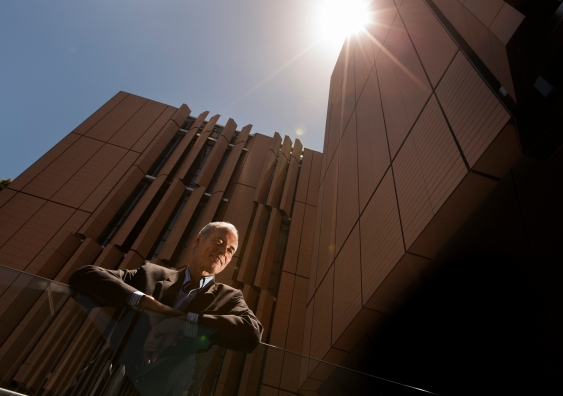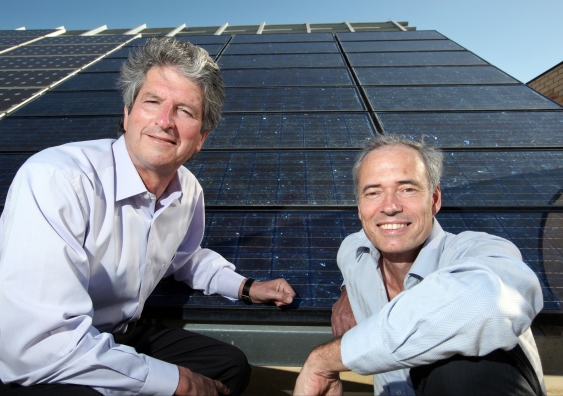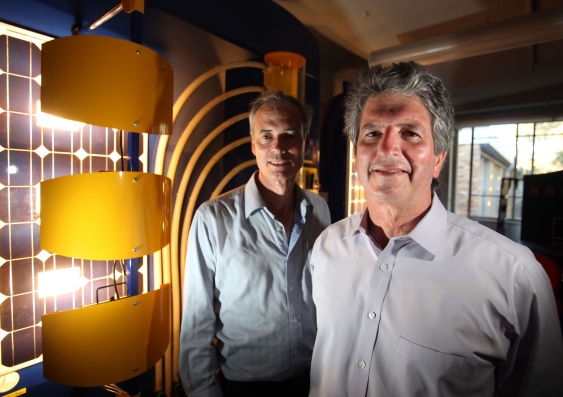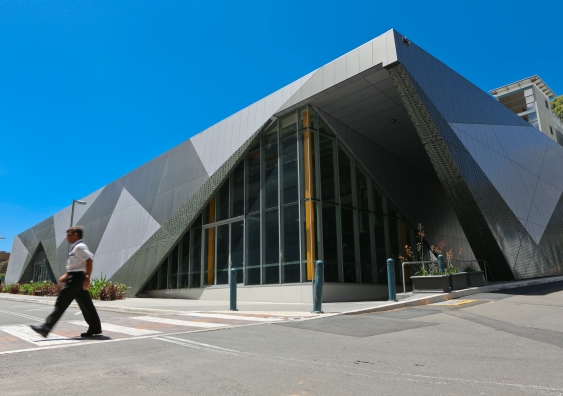Pioneering solar engineer Stuart Wenham dies, aged 60
UNSW is mourning the passing of Professor Stuart Wenham, director of the Photovoltaics Centre of Excellence, and a pioneering researcher and inventor of solar cell technologies.
UNSW is mourning the passing of Professor Stuart Wenham, director of the Photovoltaics Centre of Excellence, and a pioneering researcher and inventor of solar cell technologies.

UNSW is mourning the passing of Professor Stuart Wenham, director of the Photovoltaics Centre of Excellence, and a pioneering researcher and inventor of solar cell technologies.
Wenham passed away peacefully on the morning of Saturday 23 December with family and close friends by his side. He died from malignant melanoma, for which he had been in treatment since being diagnosed on September 8, and had hoped to make a full recovery – but his condition declined quite suddenly.
“Stuart was a wonderful colleague and an inspiring leader who will be deeply missed by all who knew him,” said Prof Mark Hoffman, UNSW’s Dean of Engineering.
“His influence as an Australian engineer on the world’s transition to renewable energy was considerable. In an incredible career spanning more than a quarter century, he invented or co-invented suites of solar cell technologies that have been licensed to solar cell makers around the world and have had a major impact on renewable energy generation.
“Stuart Wenham will be remembered for his selfless and continuous efforts to make the world a better place to live,” he added.

Professor Stuart Wenham, director of the Photovoltaics Centre of Excellence, and a pioneering researcher and inventor of solar cell technologies.
Wenham is inventor of the Advanced Hydrogenation hydrogen passivation technology, which has allowed efficiency of solar cells to be boosted a hundredfold. The technology, based on the use of lasers to control the charge state of hydrogen atoms within a silicon wafer, was heralded as a “breakthrough for silicon photovoltaics” by the UK Institution of Engineering and Technology when it awarded him the 2013 A.F. Harvey Engineering Prize.
Eight industry partners, including some of the world’s biggest silicon producers – Golden Concord Ltd and Xi’an LONGi Silicon Materials Corp, both of China – have signed agreements with UNSW to use Wenham’s hydrogen passivation technology in production lines.
“I am fortunate enough to have seen Stuart in all aspects of his life – work, family, church, sport, and friends,” said his daughter, Dr Alison Ciesla, a postdoctoral fellow at UNSW’s School of Photovoltaic & Renewable Energy Engineering. “He had the same positivity, enthusiasm, passion and care for everyone and everything in his life.
“It is some consolation knowing that he will live on through his many solar projects and the engineers he taught around the world, as well as the values and kindness he inspired in those around him,” she added.
Wenham, who studied under Australian solar energy giant Prof Martin Green, also at UNSW, went on collaborate on key research with his former mentor and to earn his own global recognition, inventing or co-inventing eight classes of solar cell technologies that have been licensed to makers around the world, including Suntech Power, BP Solar and Samsung. These companies have annual production volumes valued at hundreds of millions of dollars in an industry that is now the world’s fastest-growing in the energy sector.

Martin Green (left) and his long time collaborator and friend, Stuart Wenham.
“Stuart was wonderful and very positive person, enthusiastically supporting those around him and lightening the mood of even the tensest situation by his insightful humour,” said Green. “He was also a brilliant and creative researcher, able to see patterns in results that eluded most of us, and new ways of capitalising on these.
“He made huge contributions to the recent emergence of solar as the cheapest option for bulk electricity supply. This was not only through direct technical input, but also by his performance on ‘roadshows’, ultimately attracting billions of investment dollars into manufacturing capacity expansions. He will be very sadly missed,” Green said.
In the early 1990s, Green, Wenham and one of their standout PhD students from China, Shi Zhengrong, developed the thin-film cells CSG (crystalline silicon on glass). When Shi returned to China in 2001, he founded Suntech Power and brought in Wenham as his chief technology officer, and they quickly and radically altered the global solar landscape, using large-scale manufacturing to bring down the cost of producing silicon wafers. In just five years, the cost of making panels dropped by a factor of 10; Suntech quickly become the world’s largest solar cells manufacturer, and Shi the world’s first solar billionaire.

Stuart Wenham and Martin Green, who have reshaped the world photovoltaic industry.
Wenham served part-time at Suntech for over 10 years, spending weeks at a time in Wuxi, a city near Shanghai in eastern China which sits on the banks of Taihu, one of China's largest freshwater lakes. At one point, he managed 350 scientists and engineers on a range of research and development projects funded by 5% of the giant manufacturer’s annual revenues.
“Stuart was an amazing innovator, a considerate friend and a passionate mentor,” recalled Shi, now a Shanghai-based investor and an adjunct professor at UNSW. Shi added that during his time at Suntech, Wenham had helped commercialise high-efficiency silicon solar cell technologies in China, which had led to the “rapid progress of solar industry in the last 15 years. Stuart will be remembered as a great global solar leader who made solar affordable and accessible to everyone.”
Last week, on December 11, Wenham’s UNSW team won a $7.83 million grant from the Australian Renewable Energy Agency (ARENA) to further improving world-record commercial solar cells through recombination analysis and innovative passivation, in partnership with manufacturers SunPower, Jinko Solar and Trina Solar. His daughter is among the investigators on the project.
One of Wenham’s many legacies will be his brainchild, the Solar Industrial Research Facility (SIRF) at UNSW’s Kensington campus, a specially designed $30 million solar research R&D centre.
Dubbed ‘the missing link from lab to manufacturing plant’, SIRF seeks to commercialise the state-of-the-art manufacture of cheap, more efficient and less toxic solar cells worldwide by taking laboratory-scale solar technology and developing it for use in commercial manufacturing lines – bringing UNSW’s world-leading solar technology to industry partners globally. Architects Woods-Bagot modelled the outside of the building to mimic the pattern of multi-crystalline silicon solar cells.
A memorial service will be held on Monday 8 January 2018 at 2pm, at the Sir John Clancy Auditorium at the Kensington campus of the University of New South Wales in Sydney.

UNSW Sydney's Solar Industrial Research Facility (SIRF)
IMAGES & BACKGROUND